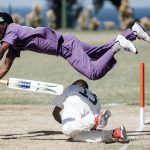India is no country for small plans
The drubbing India has inflicted on South Africa, and the Proteas’ woeful display, have made this a cricket tour to forget. But it could prepare the newer members of the team for the future.
Author:
17 October 2019

“Make no little plans; they have no magic to stir men’s blood and probably themselves will not be realised.” Architect Daniel Burnham would not have had India or cricket in mind when he uttered his words of inspiration for construction in Chicago around the turn of the 20th century.
But India is no place for small plans either and Burnham’s words were brought into sharp focus by the meek surrender of South Africa in Pune, just a week after the foundations they had laid in Visakhapatnam.
The second Test of the Proteas’ tour to India was damaging, and not only because of the chasmic victory margin of an innings and 137 runs. South Africa has suffered bigger losses before, been handed stiffer sentences for lapses in concentration. The concern now is the team’s lack of mature players bristling to head back on to the pitch to fight once more.
Captain Faf du Plessis has a formidable job on his hands. As the most experienced international in the camp, he has to reassure, counsel, cajole and convince that they are on the right track. Even as Kohli, the Sharmas, Ashwin and the relentless rest routinely snuff out the light.
Related article:
This is arguably the greatest challenge a South African captain has faced since the country’s return from isolation. The crossroads of good administration, nurturing the next generation, remaining competitive and, crucially, still enjoying it all, have converged upon Du Plessis. He has to somehow marshal all of this.
“I want to still be here. It would be the easy option to go and play in Twenty20 leagues around the world, but I love my country and I see this as something that is a big responsibility for me,” he said as the Pune sun set behind him, and his team’s hopes, in the series. “It’s tough at the moment. But the best teams in Test cricket have always had a lot of experience.”
‘It hurts, boet’
That much is true. And Du Plessis clearly wants to be around as that experience builds. But international experience takes time and, more often than not, money. These are two things that South African cricket doesn’t seem to have at the moment.
“We will have to be patient and accept that guys will fail on their way. It’s hard and we are proud, and it hurts to lose,” Du Plessis sighed. “It hurts, boet.”
The giant scoreboard at Pune Stadium went dark as he lamented the Proteas’ loss, the reminder of the huge margin of India’s victory removed from view. But the events of the previous four days were still writ large on the face of South Africa’s captain.
Clenched jaw, searching eyes and pursed lips all pointed to jilted ambitions, but Du Plessis admitted that he had been here before.
“We took learnings from 2015. This is a tough place to tour and this is a very, very good Indian team, especially in their own conditions,” he said.
Du Plessis was there in 2015, as were the two South African century scorers in Visakhapatnam, Dean Elgar and Quinton de Kock. It is no coincidence that they have scored the bulk of the runs for South Africa, because India is a unique challenge where the smallest margins are exaggerated.
Batting challenge
A batsman, especially, can appear lost in the middle, searching for his next run. Aiden Markram, one of the finest talents to emerge from South African cricket in recent years, wore that vacant expression in Pune as he bagged a grim pair of noughts. His dismissal in the second innings, trapped leg-before by a ball that would have comfortably missed the stumps, seemed a microcosm of his struggles.
In India, the batting challenge start with the hands, which go searching for balls beyond their jurisdiction. The feet follow, becoming paralysed by fear of the known and unknown. And then, because of those two failings, the mind begins to play tricks, turning perfectly innocuous deliveries into snake-pit offerings.
But the real problem arises when batting looks to become a case of survival. When you make meek and small plans to merely exist on Indian tracks, instead of fighting back when opportunities to score arise, then you are surely sunk.
Related article:
Kevin Pietersen of England loved playing in India because he always felt that most spinners didn’t deserve to even bowl to him. That ruthless streak stood him in good stead and his 186 in Mumbai in 2012 remains a masterclass in foreign batting on Indian tracks.
Matthew Hayden of Australia was as confrontational as the day is long, walking fast bowlers down and mowing them and their new ball over mid-wicket on principle.
No small plans.
They were two of Test cricket’s great attackers, though, and they were brave enough to press the accelerator even when the chips were down. They were surrounded by experience that could repair the damage if they were dismissed.
Freedom of expression comes at a price and South Africa can’t afford those premiums at the moment. The Proteas’ most naturally attacking player is De Kock and he showed some of his best work in the first Test. He held India captive with his panache and almost toyed with the bowling. But in Pune, he walked into a scene where Elgar had laid a foundation. It is a different matter to commit to attack when there is carnage all around.
Du Plessis doesn’t shirk going through the gears. But the dual role of playing enforcer and guardian is sapping.
“You need time in India. I learnt some big lessons about myself in 2015 and I’ve tried to bring those into the team now,” he said of the rite of passage that is batting and thriving in India.
A team under construction
The problem for Du Plessis is that where he once looked around the dressing room and saw Graeme Smith, Hashim Amla, AB de Villiers and Dale Steyn, he now has a class of freshmen still making their way in the wild Wild West of Test cricket. As their leader, he also has to be hypercritical of his own returns, especially once he has settled at the crease.
“You need to make big contributions that can change a match. [Scoring] 50s and 60s won’t do that, and you’ve seen India get big hundreds. That is what we have to do as senior players.”
In acknowledging all of that, and highlighting South African shortcomings with bat and ball, it is also instructive to remember India’s formidable record at home.
Related article:
This is now their 11th successive series triumph on home soil. No visitor wins here anymore and under the rabid instruction of Virat Kohli, India is like a Rottweiler feasting on a juicy bone. They demoralise meek visitors with spin and fluent batting and, most notably, with the most improved fast bowling in world cricket.
They would have taken great pride that it was their pace attack, without the brilliant Jasprit Bumrah, that punctured the big holes in the South African team. India’s singular obsession is to be the best team in the world.
That is no small plan, but it is a bold vision that South Africa once held. It is up to Du Plessis to remind the next wave of South African players that it is always darkest before the light. And that it was just as dark in 2015, when South Africa still held most of their playing aces.
To raise themselves once more for inhospitable Ranchi will be a mighty task, but Du Plessis has no choice but to implore his wilting Protea buds to face the fire of India once more. And they will have to face it sincerely, with no feet on the plane home to familiar tracks that bounce like concrete.
Burnham’s Chicago wasn’t built in a day and neither will the new South African Test team. They will have to rebuild, one painstaking brick at a time.
But somewhere during the course of the reconstruction of a once mighty building, those who were humbled in India in 2019 will recall the wounds and point to the scars that made them better players. And perhaps made them the makers of bold plans that stirred the blood and more.



